A TestingSaaS guestblog on A/B testing by Ilan Nass, Chief Strategist Taktical Digital
Facebook is a valuable marketing tool. With approximately 2.38 billion active monthly users, the platform gives you access to many potential leads.
But if you think Facebook Ads are something you can set and forget, think again. To get results you desire for a sane amount of ad spend, you need to study your results and optimize accordingly. There are a lot of metrics to track when it comes to creating ad campaigns that slice through the noise. Once you’ve decided on a smart metric, it’s time to design an A/B test. This simply involves testing multiple versions of an ad or campaign to determine which is most effective. The following points will help you better understand how to go about this process on Facebook.
What Not to Do
Before exploring how to properly A/B test, it’s important to brush up on mistakes you should avoid. They include:
- Testing too much content at the same time: If you test too many ads or pieces of content at once, it will be difficult for you to confidently identify which content yielded results, and which failed.
- Testing minor changes: When A/B testing ads, they should be different enough that you can glean genuine insights from their performance. Simply changing one line in an ad isn’t enough to help you understand what does and doesn’t work.
- Not providing equal opportunities: You need to design your test so that both ads involved have the same opportunity for success. For instance, if one had a higher budget or was targeting a stronger audience, it might outperform the other, despite not truly being any better.
Instead, follow these tips to A/B test effectively:
Only Test a Single Element
Again, it’s important that your ads be noticeably different when A/B testing on Facebook. That doesn’t mean you should make every element different. You’re better off changing one element when generating multiple versions of the same ad. Change the ad copy, or the image, or the audience, etc. While the changes need to be substantial enough to make a difference, they do need to be restricted to a single element.
Don’t Test Merely Two Ads
The name “A/B testing” implies testing only two versions of a given ad at a time. In some instances, this may be appropriate, but you can often get more valuable insights if you test three to five versions of an ad. When doing so, you may want to make the ads significantly different.
For example, maybe you’re running an ad promoting a product. One ad may feature an image in which the product is foregrounded, with accompanying text explaining its features and benefits. Another ad may include minimal text, with an image that shows the product in action. Yet another might include substantial text in the image, with the product itself taking up less space. This gives you three ads that are different enough from each other to offer valuable information.
Don’t Draw Conclusions Right Away
You need to give your ads a sufficient amount of time to reach users before drawing any conclusions. For example, if you ran an ad asking people to sign up for your email newsletter, with one slightly outperforming the other after a week has elapsed, you might assume that ad is stronger. Although this may be true, it’s smarter to wait two or three weeks to start analyzing data. The more data you have, the more confident you can be in your insights.
Keep in mind that A/B testing does require you to invest some time and money. However, in the long run, the value is worth the investment. Knowing what types of Facebook ads resonate with users is key to optimizing your return-on-investment.
Do you also want to guestblog on TestingSaaS?





